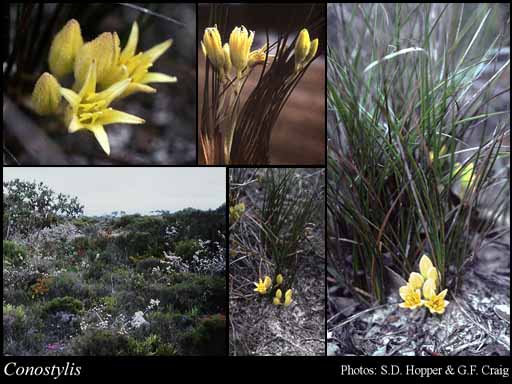- Reference
- Prodr.Fl.Nov.Holland. 300 (1810)
- Name Status
- Current







Scientific Description
Common name. Cone Flowers. Family Haemodoraceae.
Habit and leaf form. Herbs; with coloured juice, or non-laticiferous and without coloured juice. Perennial. Leaves basal, or basal and cauline (mostly basal). Plants with a basal concentration of leaves (leaves all radical); rhizomatous (not red internally). Rhizome and root tissues brightly red-pigmented, or not red-pigmented. Mesophytic, or xerophytic. Leaves medium-sized to large; alternate (tufts at nodes); distichous; leathery; sessile; sheathing. Leaf sheaths with free margins. Leaves edgewise to the stem, or with ‘normal’ orientation; simple; epulvinate. Leaf blades entire; flat, or solid; linear (or ensiform); linear; parallel-veined; sheathing. Leaves without stipules. Leaf blade margins with spines or cilia. Leaves with a persistent basal meristem, and basipetal development. Vernation conduplicate. Leaf anatomy. Guard-cells not ‘grass type’. Hairs present, or absent. Branched hairs present. Extra-floral nectaries absent. Stem anatomy. Secondary thickening absent.
Reproductive type, pollination. Fertile flowers hermaphrodite. Unisexual flowers absent. Plants hermaphrodite. Floral nectaries present. Nectar secretion from the gynoecium (via septal nectaries). Entomophilous, or ornithophilous, or pollinated by unusual means.
Inflorescence and flower features. Flowers solitary (rarely), or aggregated in ‘inflorescences’; in cymes, or in heads (head-like). The terminal inflorescence unit cymose, or racemose. Inflorescences scapiflorous; terminal; flowering scapes from the stem apex among the leaves, 1-several per plant, longer or shorter than the leaves, branched or unbranched, hairy, with a few distant bracts; inflorescence 1-many flowered, 1-sided or spherical. Flowers pedicellate (shortly); bracteate; ebracteolate; regular (usually); 3 merous; cyclic; tricyclic, or tetracyclic. Perigone tube present. Perianth of ‘tepals’; 6 (in 1 whorl); 2 -whorled; isomerous; petaloid; similar in the two whorls; cream, or yellow, or orange, or purple (colours due to branched plumose hairs). Androecial members definite in number. Androecium 6. Androecial members adnate; all equal; free of one another; 1 -whorled, or 2 -whorled. Androecium exclusively of fertile stamens. Stamens 6; all more or less similar in shape; diplostemonous; near the top of the tube; alterniperianthial. Filaments appendiculate (minute), or not appendiculate (usually). Anthers basifixed (or partly free); versatile, or non-versatile; dehiscing via longitudinal slits; introrse; unappendaged, or appendaged (apically, from the connective). Gynoecium 3 carpelled. The pistil 3 celled. Gynoecium syncarpous; eu-syncarpous; partly inferior, or inferior. Ovary plurilocular; 3 locular. Gynoecium stylate. Styles 1; when 3, partially joined; attenuate from the ovary, or from a depression at the top of the ovary; apical; much longer than the ovary at anthesis. Stigmas 1; minutely 3 - lobed; capitate. Placentation axile. Ovules few to many; non-arillate; orthotropous to hemianatropous.
Fruit and seed features. Fruit non-fleshy (coriaceous); dehiscent; a capsule. Capsules loculicidal. Fruit 3 celled. Seeds copiously endospermic. Endosperm oily. Seeds winged, or wingless. Cotyledons 1. Testa without phytomelan.
Etymology. From the Greek for "cone" and "column, style"; the summit of the ovary/base of the style is conical.
Taxonomic Literature
- Wheeler, Judy; Marchant, Neville; Lewington, Margaret; Graham, Lorraine 2002. Flora of the south west, Bunbury, Augusta, Denmark. Volume 1, introduction, keys, ferns to monocotyledons. Australian Biological Resources Study.. Canberra..
- Hopper, Stephen D. 1980. The Conostylis aculeata group.